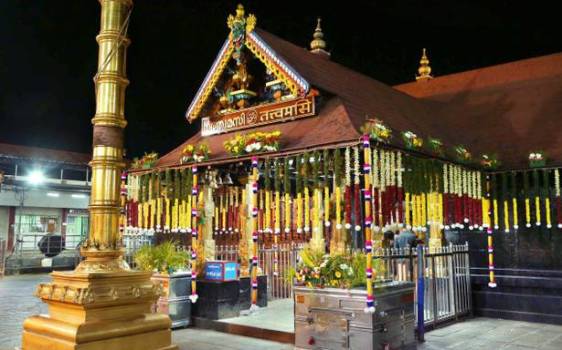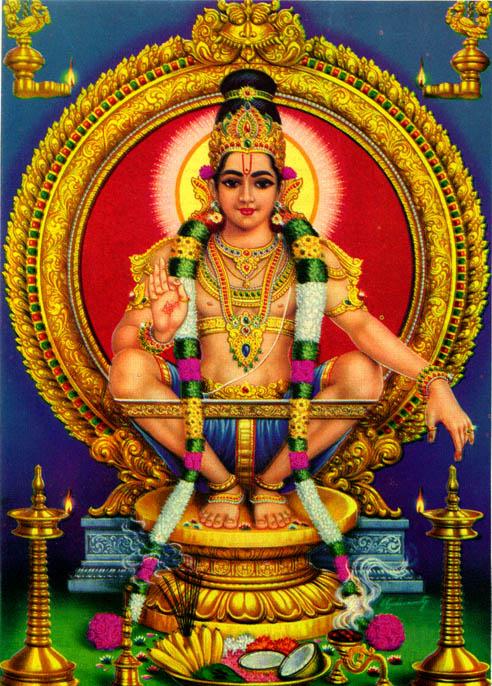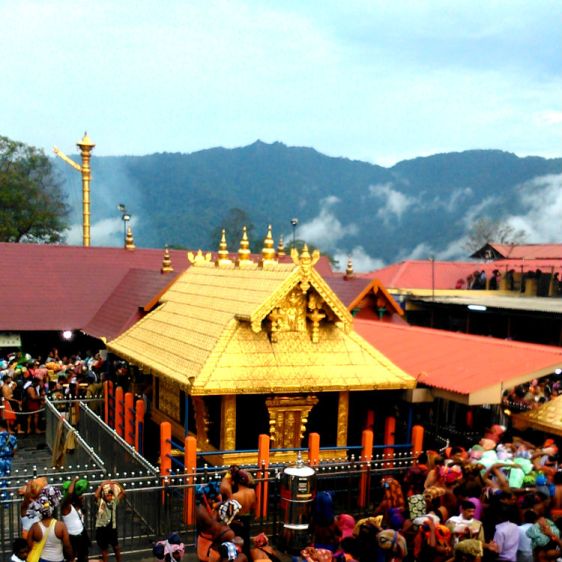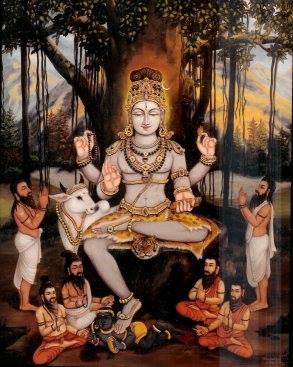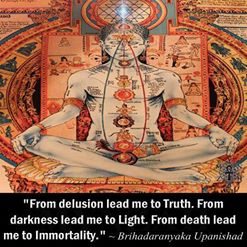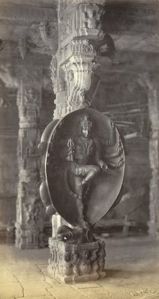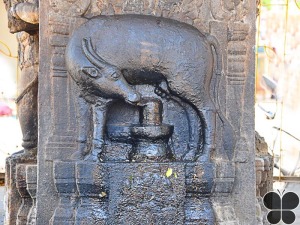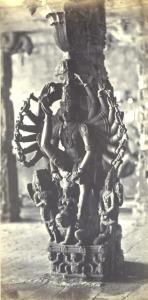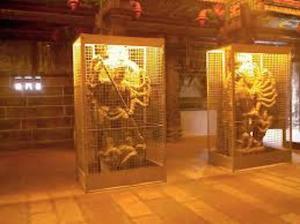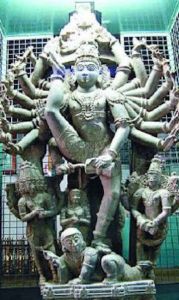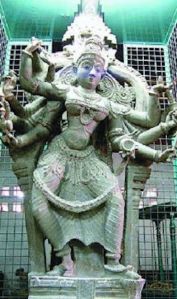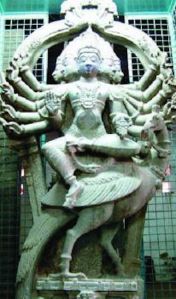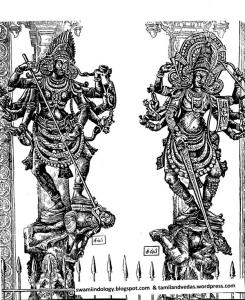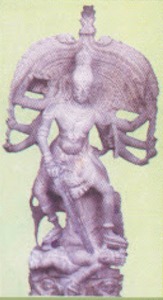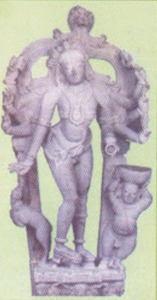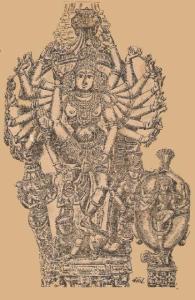In creating the Death card, usually one of the most feared and misunderstood cards of the Major Arcana, we had the choice of going with Yama who is the designated figure in the mythological ethos or go with Kali – who is psychologically more accurate. In the end we kept both of them in, a masculine and feminine polarities choice, and I am glad we did. I also wish to say something about the Issues surrounding the Death card. Today the norm all over seems to be to treat the card symbolically, as a transformation, a process of change and so on and so forth. While not inaccurate, the Tarot was created in historical circumstances when life expectancy was only about 40 or 50 years and the Death card would have been literally true in a reading for a good long while. To pretend it was not so, and could still be so, is foolish.
Sacred India Tarot
Notes on its Creation: Card 13, Death (1):
Lord Yama
In November 2001, Rohit wrote to Gautam: “Urgently send Jane a message that I am in a bit of a fix as to the Death card. Yama is right, but so is Kali. Only problem is, Kali has bad odour outside, and weight of conditionings may be too much to overcome. On the other hand, Kali provides balance; Laxmi, Saraswathi, Kali – red, white and black gunas, just as the male deities Siva, Vishnu and Brahma are represented. This needs some thought, what do you feel? I am slightly prejudiced in favour of Yama, as it gives an opportunity to give a Vedic perspective. Perhaps we should ask Jane? Or even better idea, have two Death cards, for various levels of awareness, with text to justify both – a male Death and female Death. I think no pack in the world has such a concept, it would be wonderful …”
The Sacred India Tarot has indeed, two cards for Death: Lord Yama, and Mother Kali as the shakti power. We now tell our story of the first one, Yama.
Here to begin with, is the western Tarot representation of Death:

Death – Key 13 of Jane’s Hermetic Tarot deck. In the west, this Arcanum symbolizes “movement” – “the Imaginative Intelligence” of Nature, associated with the sign Scorpio and the reproductive force.
Here is a poem, first drafted by Alan Jacobs:
The reaper wields his scythe of dread
to harvest life, leaving chaff for dead.
All are re-born, in heaven or earth
with Nature’s labour, time since birth.
Most fear the Enigma’s spectral tread.
But some there be, who Death don’t rue.
Death distils an essential view.
The force enquires within the quest!
To look for real ‘I’ in the bones is best
to flower a Mystery, sure and new.
“The dead must bury their dead,” said the Preacher.
The moving image is our teacher.
(Alt. – Within an apple’s flesh, the core is best, For seed itself to find, a life fecund and new.
Or: To seek within our flesh the bone is best …
**
Rohit’s Article: Yama – Forerunner, First Man, God of Death
Yama in Hindu mythology is usually known as the god of Death. He is also supposed to conduct a Last Tribunal where the good are rewarded, and the evil get their lumps. This does not in any way increase his stature in the popular imagination, where he has frankly, no place at all. At best it is resignedly accepted, it is better the process of death and punishment for sins be regulated. His realm is supposed to be dank and gloomy, filled with assistants who are visual variants on his own form – colossal, green skinned, red-robed, and of terrible appearance, accentuated by the fact that he rides on a buffalo and carries a fearsome mace and the deadly noose with which the soul is snared and removed from the body.
None of this does any justice to Yama as he used to be – a great ethical examplar of the Vedic and Upanishadic times. He was also the first great Hero amongst Men, ascending to divine status because he was not afraid to learn the riddle of death by dying.
All the Vedic gods have lost stature, but Yama is a really sad example of decline in a culture. The name Yama means “The Restrainer”. Further refining it, we get “The Restrained One.” This is not surprising, considering his origin. In a magnificent dramatic irony, Yama is supposed to be the son of Surya, the Sun god and giver of Life. Life cannot proceed without intimate acquaintance with death. Indeed, death clears the old out of the way of Life. The Veda is clear that Yama’s great achievement on behalf of the race of men was to find the way home which cannot be taken away. It is by dying that man achieves immortality, and Yama was the first to discover this secret.
Not without trouble, however! For Yama and Yami were the first humans to be born, the Primordial Twins so beloved of mythic structure. Yami was in no hurry to learn the Eternal Secret. She would much rather Yama learnt with her what it was to be fruitful and multiply. This was acceptable by the standards of myth and all Genesis tales: the first couple usually populated the earth through incest. Yama is having none of it, and rejects Yami’s specious argument that even in the womb, which they shared, they were designed to be man and wife. She also urges upon him his duty to the world. If they are all that live, they owe it to life to procreate and trust that posterity will be indulgent with the moral implications of what they had to do. The verses where she urges him on in this expedient course of action, are some of the most blatantly erotic written in any human language:
“Desire for Yama overwhelms me Yami –
to lie with him in a common bed
as a woman to her husband I would yield my body.
Like chariot wheels let us surge to and fro!”
Yama’s answers are a standing monument to ethical imperatives, a blanket repudiation of expediency and comfort zones. He simply refuses to lower his standards, no matter what the emergency. Evil has no extenuating circumstances. “Shall we do now what has been diligently spurned hitherto? Shall we who speak truth, now countenance wrong?”
For him all actions are to be judged in the light of Ritha, Cosmic Law. It is better the earth remain unpopulated than be filled with the fruits of sin. He has greater, and more justified, confidence in the universe than Yami does, for life does not snuff out, contrary to her dire predictions. This refusal to procreate sinfully, is Yama’s true victory over death, for Men reproduce hoping to cheat Death with every new generation. For immortality is gained not in using one’s children to cheat death, but by experiencing Death itself as a door to immortality.
Yama does not begin as a god. He earns that distinction. He is merely a man to begin with, but he is not afraid to grow into his full potential. He is not afraid to travel beyond the veil. He is the first man to die, and the first man to learn about death without any fear of it. That makes him the Lord of Death. Indeed, so great is his power over death, that he is even called Mrityu, Death itself. Since he was the first sinless man to cross over, he becomes Lord of that realm, and is also entrusted with a new responsibility, guarding the Dharma. Hence his title Dharma Raja – Lord of Dharma.
It is a remarkable concept. Death alone can reveal the true ethical and moral stature of a human life; while that life is being lived, the issue always hangs in balance. The judgement seat of Yama thus evolved in later myth, helped by his assistant Chitragupta, India’s Recording Angel who has every deed of a life stored away in his infinite ledgers. This is the classic Weighing of the Scales, a great and momentous decision that only the first Man, the Forerunner, who showed the race of man the path to salvation, is entitled to take. It dramatically represents Shaw’s famous phrase: “Life levels all men, but Death reveals the eminent.”
Yama’s death had another interesting consequence. For Yami went into a great inconsolable gloom, that rapidly threatened the Universe. The gods urged her to let it go, to forget the death of Yama and get on with living. To all their remonstrance, she had only one answer – “Yama has died but today, and you want me to forget so soon?”
Since the First Days had been created without any nights, this was indeed an insurmountable difficulty! To help put some distance between Yami’s distress and the event causing it, the gods invented Night. Thus came into being the morrow, the passage of time and the dimming of memory, which assuages grief. “Night and day together let sorrow be forgotten,” says the Veda about this. Also, Yama seems to have traveled to the south to learn about the great transition of Death; he has been deemed the guardian of the South quadrant, and it is also the direction of death. To sleep with your feet pointed south is regarded as an invitation to travel on the long journey, and is avoided in Indian culture.
… … …
Yama has a great role left to play in the KATHA UPANISHAD, where the boy-Rishi Nachiketas travels to his realm, seeking instruction from the only god who really knows the secret and mystery of Death. This text is one of the glories of Indian literature as well as philosophy, and it is worth perusing in its own right. Yama tries to dissuade the boy from asking to learn about matters even the gods prefer to avoid in ignorant bliss, but seeing that his resolution would not be shaken, he fires from both barrels in a tremendous opening statement of truths. “The Good is one thing. The Pleasant is another.” He then takes the boy through ever ascending realms of Awareness and ends up with a blunt statement of reality about the Path:
“Steep as the mountain slope, sharp as the razor’s edge is the Path.
Nevertheless – Arise! Awake! Stop not till the Goal is reached!”
In the Mahabharatha, Yama is the father of the ethical Hero Yudhistara. He is also famous in the text for having a contest with the wise Savitri, who is determined not to let the Lord of Death and Righteousness have the soul of her husband Satyavan. Yama holds out as long as he can, showering boons on the devoted girl in a vain attempt to distract her from her purpose, but she is in every way his intellectual equal, and her love is too strong for him to resist. He is only too glad to admit defeat, and restore the Prince to life.
Sri Aurobindo used this myth to write the longest poem in the English language – Savitri. It is also a text of ascending levels of awareness of the Spirit. In the Mahabharatha, there is also another famous section, where Yama takes on the form of a Yaksha spirit, and questions his brilliant son on virtually everything. These questions of the Yaksha are a compendium of aphoristic brilliance and wisdom. The final question he asks, is perhaps the most apt:
“What is the greatest wonder of the world? Every day thousands of men go to Yama’s abode, yet no man thinks of the implications of his death.”
Yama has many names, all of which indicate in some way or other, his role as Cosmic Judge and upholder of the Just. He is Samana “the Settler”, Dandha-dhara the bearer of the Rod – symbol of authority and punitive powers – Pitri-Pati, or Lord of the Manes (ancestors). Yama is also known as Kritana, the Finisher. Everybody comes to him, sooner or later, and the myriad self-deceptions that everyone thinks make up life, are of no use any more. Greater Life is possible only if we remove all tendencies to evil. If we do not, Yama will find them out and judge us on them.
To know Yama, is to know that you live by what dies within you.
**
From the KATHA UPANISHAD:
Nachiketas: “When a man dies, this doubt arises; some say ‘he is’ and some say ‘he is not’. Teach me the truth.”
Death: “Even the gods had this doubt in times of old; for mysterious is the Law of life and death. Ask for another boon. Release me from this …”
Nachiketas: “… All these pleasures pass away, O End of all! They weaken the power of life. And indeed how short is all life! Keep thy horses and dancing and singing … I can only ask for the boon I have asked.”
Death: “… There is the path of joy, and there is the path of pleasure. Both attract the soul. Who follows the first comes to good; who follows pleasure reaches not the End….
**
Nachiketas: “Tell me what you see beyond right and wrong, beyond what is done or not done, beyond past and future.”
Death: “I will tell you the Word that all the Vedas glorify, all self-sacrifice expresses, all sacred studies and holy life seek. That Word is OM. That Word is the everlasting Brahman; that Word is the highest End. When that sacred Word is known, one is great in the heaven of Brahman. Atman, the Spirit of vision, is never born and never dies. Before him there was nothing, and he is ONE for ever more. Neverborn and eternal, beyond times gone or to come, he does not die when the body dies. If the slayer thinks that he kills, and if the slain thinks that he dies, neither knows the ways of truth. The Eternal in man cannot kill; the Eternal in man cannot die.
“Concealed in the heart of all beings is the Atman, the Spirit, the Self; smaller than the smallest atom, greater than the vast spaces. The man who surrenders his human will leaves sorrows behind, and beholds the glory of the Atman by the grace of the Creator. Resting he wanders afar; sleeping he goes everywhere. Who else but my Self can know that God of joy and sorrows?
“When the wise realize the omnipresent Spirit, who rests invisible in the visible, and permanent in the impermanent, then they go beyond sorrow.”

Rohit’s Notes:
“Please do not portray Yama in any sort of hell like condition. He is the great judge, as well as the first who went forth. Yama was the first man to die, and he became the Lord of death and Judge of all men. He is green in complexion, while his clothes are bright red in colour. His eyes are red too, but they are somewhat reptilian in that they never blink. He carries a golden mace and a fearsome noose in the right and left hands respectively. We will send a picture, but the common perception of Yama is both distressing and mistaken. His head should have a warrior’s helm, NOT the absurd buffalo horned Viking helmet so beloved of Indian art. He rides a buffalo, but that is an optional extra for the illustration.
“Yama’s body should indicate great muscular development, and he should be a young man. The popular images show him to be fiercely moustached and impossibly pot bellied. None of that. In the Vedas it is very clear that he was in the prime of his life, and so greatly handsome and virile that his own sister fell in love with him and tried to tempt him into an act of primal Incest. He was the first Man, as well as first god, to pass over and learn the great Mystery of death – knowledge that makes him privy to wisdom denied to the other gods. This is clear from the Katha Upanishad and the dialogue with Nachiketas therein.
“Yami his sister refused to stop mourning for him, and answered every remonstrance of the gods who felt this was overdoing grief, by saying ‘Yama has but died this day and you want me to stop grieving for him!’ In order to help her to heal, they invented the night, so that she could sleep, so that time might be counted off in days, and healing and acceptance begin.”
Correspondence: Jane – “Many thanks, the texts for Yama and Kali (for the creation of Kali, see next post) are most illuminating. I had begun the Yama drawing, and it is along those lines already. Rohit’s essay on Yama is so good … I have a bad cold today and unable to work.”

An early impression/sketch for Yama, while reading Rohit’s notes.
Jane’s Notes/Journal: 23 August 2002
“Alchemy is either deteriorating or re-arranging my formerly rude physical health. Quite poorly yesterday, with very sore fiery inside-linings, face, eyes and streaming. Last night I at last got going on SE (Self Enquiry the Ramana Foundation Quarterly) as the current task, inspired by Rohit’s excellent article on Yama – who I began to draw for India Tarot the day before – which I follow up by typing in the whole of the Katha Upanishad, and will include some of Aurobindo’s Savitri with Yama as well. It works as soon as I feel ‘led’ by the Companions in this task, and no longer a disgruntled editor …
“Mrs B rang to announce she’s off to Brockwood for the weekend, and I told her of my nightmare, and she reminded me of my “little friend” here dying last week (Alexander) and the kind of demands this couldn’t help making, and what it feels like to be them, and the ABYSS we both know, which is in its way, death, the terror of indefinition; and how fascinating it all is… Thus: permit this hinterland, and let it, if it will, unknot.
24 August 2002
“SE will grind along alright now that Yama gave it a kick start; the magazine becomes automatic and time-passing work, convinced that it is useful. I copied out the whole of the Katha Upanishad, and exciting passages from Aurobindo’s Savitri…
25 August 2002
“Yesterday I went for a walk and a doze on the Heath, and when I came back I spent the whole evening on Yama, it is now a beautiful painting, my favourite of all the cards I have drawn so far. It combines the boy Nachiketas with the version of Mrs Yama too – the erotic Yami – and includes under Lord Yama’s buffalo, those sprouting hands, feet, leaves and flower-buds in the dark, of the Western Tarot version as death’s harvest (scythe). In the east, Yama does it with a noose. Yama rides mildly through the shadowed forest, his mace is like a lamp, his noose a source of Light, his green skin complementary to his eyes and the fiery red cloth that swathes him. The buffalo is white. Young Nachiketas, who inquires into the depth of eternity, attracts his interest and attention. But Yami his sister, dramatizes the traditional tokens of grief and death in a twilit region. This region however, is one of abundant fertility and transformation. She and Nachiketas seem to represent night and day. Lord Yama presides over these states from a region beyond them, which includes them.
The green and red of Yama himself in this painting, against flowing greys and violets, enchants my inner eye. Magic is in it. He is the wisdom god Yama, with young Nachiketas; it has a deep and subtle feeling.
“Gautam sent from Bombay by email, colour images of Kali and of Ganga.”
From the KATHA UPANISHAD:
In the secret, high place of the heart, there are two beings who drink the wine of life in the world of truth. Those who know Brahman, those who keep the five sacred fires, and those who light the three-fold fire of Nachiketas, call them ‘light’ and ‘shade’.
May we light the sacred fire of Nachiketas, the bridge to cross to the other shore where there is no fear, the supreme, everlasting Spirit!
This by which we perceive colours and sounds, perfumes and kisses of love; by which alone we attain knowledge; by which verily we can be conscious of anything; this in truth is That … When he knows the Atman, the Self, the inner life, who enjoys like a bee the sweetness of the flowers of the senses, the Lord of what was and of what will be, then he goes beyond fear; this in truth is That …
The goddess of Infinity who comes as Life-power and Nature; who was born from the elements, and rests, having entered the heart; this in truth is That. Agni, the all-knowing god of fire, hidden in the two friction fire-sticks of the holy sacrifice, as a seed of life in the womb of a mother, who receives the morning adoration of those who follow the path of Light or the path of work: this in truth is That. Whence the rising sun does come, and into which it sets again; wherein all the gods have their birth, and beyond which no man can go ;
…
Who sees variety and not the unity, wanders on from death to death.
The soul dwells within us, a flame the size of a thumb, is the soul; the Lord of the past and the future, the same both today and tomorrow: this in truth is That. As water raining on a mountain-ridge runs down the rocks on all sides, so the man who only sees variety of things, runs after them on all sides. But as pure water raining on pure water becomes one and the same, so becomes, O Nachiketas, the soul of the sage who knows.
**
I will now speak to you of the mystery of the eternal Brahman; and of what happens to the soul after death.
The soul may go to the womb of a mother, and thus obtain a new body. It may even go into trees or plants, according to its previous wisdom and work. There is a Spirit who is awake in our sleep, and creates the wonder of dreams. He is Brahman the Spirit of Light, who in truth is called the Immortal. All the worlds rest on that Spirit, and beyond him no one can go. This in truth is That.
As fire, though one, takes new forms in all things that burn, the Spirit, though one, takes new forms in all things that live. He is within all, and is also outside.
**
The Tree of Eternity has its roots in heaven above and its branches reach down to earth. It is Brahman, pure Spirit, who in truth is called the Immortal. All the worlds rest on that Spirit, and beyond him no one can go. This in truth is That. The whole universe comes from him, and his life burns through the whole universe. In his power is the majesty of thunder. Those who know him, have found immortality.
**
When the five senses and the mind are still, and reason itself rests in silence, then begins the Path supreme. This calm steadiness of the senses is called Yoga. Then one should become watchful, because Yoga comes and goes.
**
One hundred and one subtle ways come from the heart. One of them rises to the crown of the head. This is the way that leads to immortality; the others lead to different ends.
Always dwelling within all beings, is the Atman, the Purusha, the Self, a little flame in the heart. Let one with steadiness withdraw him from the body, even as an inner stem is withdrawn from its sheath. Know this pure immortal light; know in truth this pure, immortal Light.
And Nachiketas learnt the supreme wisdom taught by the god of after-life, and he learnt the whole teaching of inner-union, of Yoga. Then he reached Brahman, the Spirit Supreme, and became immortal and pure. So in truth will anyone who knows his Atman, his higher Self.
Extracts from the Katha Upanishad, Juan Mascaro translation

Correspondence: Gautam and Rohit: -3 September 2002
“The Death cards are to die for. Yama: This is a brilliant card … only minor correction, the horns make it look more like a bull than a buffalo. We are sending you a reference for the same. Kali (this painting was done again) – This is the most powerful representation we have seen in a long time. However …”
(See next post, in this series.)
Rohit Arya is an Author, Yogi and Polymath. He has written the first book on Vaastu to be published in the West, {translated into five languages} the first book on tarot to be published in India, co-authored a book on fire sacrifice, and is the creator of The Sacred India Tarot {82 card deck and book}. He has also written A Gathering of Gods. He is a corporate trainer, a mythologist and vibrant speaker as well as an arts critic and cultural commentator. Rohit is also a Lineage Master in the Eight Spiritual Breaths system of Yoga

